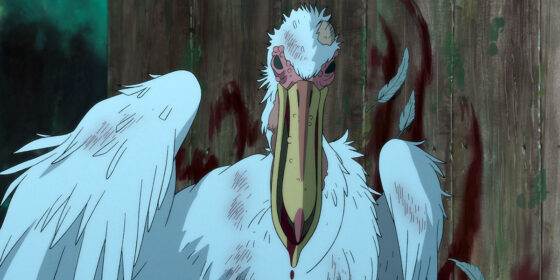TIFF 2023 | The Boy and the Heron (Hayao Miyazaki, Japan) — Gala Presentations

By Will Sloan
In the weeks leading up to The Boy and the Heron’s Japanese release in July, Studio Ghibli offered no stills, no trailers, no clips—just a poster (with a hand-drawn image of a heron) and the promise that its beloved maker, Hayao Miyazaki, was back. That the film was a monster hit speaks not only to the strength of Miyazaki’s reputation at home, but also to the special weight of his images. There are very few filmmakers who can be reasonably expected to deliver images we’ve never seen before, and that lodge forever in the mind, and it’s not just Miyazaki’s visual imagination, but also the feeling behind the images that gives them weight. One that I’ve never been able to shake is the sight of little Chihiro’s parents first transformed into hogs at the beginning of Spirited Away—so perfect a visual analogue for a childhood fear so primal that I can barely think of it without getting emotional.
North American audiences won’t have quite as pure an experience with The Boy and the Heron as our Japanese counterparts. We’ve had a trailer, as well as a widely-circulated still of the titular heron—who, as it turns out, is a layered beast, with the outer-skin of a bird that houses an inner-self who looks a bit like Danny DeVito. When this still was first released, I saw a few people get mad online, and I can sympathize; Miyazaki’s images have earned such significance that a lot of us want to be protective of how we first encounter them. Without devolving into a laundry list, I’ll just say that this is replete with the expected visual delights—from those gorgeous, Monet-like hand-painted backdrops, to eccentric creatures like the “Warawa” (little blob-like spirits that become human souls), to smaller details like the look of jam as it’s spread over a piece of bread, or blood as it flows down a character’s face, or the way a 1940s car jitters when it’s being revved up.
That’s just the tip of the iceberg—to tell you the truth, I’m a little overwhelmed. It’s rare to encounter a movie with this much stuff in it, and it’s impossible to know exactly how or if these images will foment in the memory and the subconscious the way that Miyazaki’s so often do. So consider this a note on first impressions. I can tell you that like Spirited Away, the story involves a child’s journey through an alternate realm to retrieve a parent. This time the hero is a boy in 1943 Japan whose mother perished in a bombing raid, and who is now uncomfortably resettled in the country after his widowed father has married her younger sister. When his new stepmother disappears into an alternate realm, he goes to rescue her, and soon finds himself crucial to the very balance of the universe. Delineations remain unclear in Miyazaki’s work between man and beast, or corporal reality and the netherworld, but this universe is less grounded. The feelings that made Spirited Away feel so primal are here, but more than any of his other movies, this film seems to be inventing its cosmology as it goes along. It’s a disorienting experience, but exhilarating too. I’m also struck again by how eccentric the many creatures are, and how tenderly Miyazaki seems to love them, and if you stop to chat with one of a vast flock of pelicans, he will tell you about his struggle.
Will Sloan

